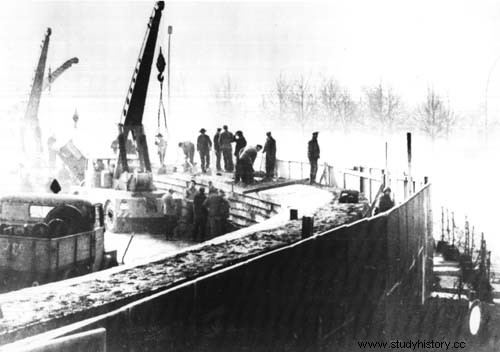- The construction of the Berlin Wall took place during the Cold War, which opposed the two victorious superpowers of the Second World War:the United States and the Union of Soviet Socialist Republics (USSR).
- Germany, at the end of the Second World War, was divided into four zones, each being administered by an Allied power. The geopolitical recomposition around the Cold War led to the creation of the FRG (West Germany) and the GDR (East Germany).
- Several million Germans left the GDR for the FRG, for economic reasons, or to flee the communist regime. The Berlin Wall is built to prevent this emigration.
- Berlin, like Germany, is an occupied territory divided between the Allies. The German capital is an important crossing point between the two areas.
August 12-13, 1961

Characters
Nikita Khrushchev
John Fitzgerald Kennedy
Willy Brandt
Procedure
On the night of August 12 to 13, 1961, workers, under the protection of the Soviet army, laid barbed wire around West Berlin. The following days, the accesses between the two zones are blocked by the Russian soldiers, interrupting the means of transport. The Brandenburg Gate is closed on August 14. Troops are stationed in front of Allied border posts.
These barbed wire barriers were later replaced by concrete slab walls. The work is spread over several months. The authorities of the GDR also walled up the entrances and windows at the garden level of the buildings. Squares and quarters are arbitrarily divided.
On October 25, 1961, at “Checkpoint Charlie”, American and Soviet tanks faced each other. The border guards of the GDR demand the control of the authorities representing the countries of the West. This moment marks the significant tensions of the Cold War.
Thus, overnight, Berliners are deprived of movement between the two areas. A certain number of Berliners, residing in the East, can no longer go to their place of work, in the West. The Berlin Wall, in the inner portion of the city, extends over a length of 43.1 kilometers, for a height of 3.5 m.
Consequences
- The Berlin Wall remains one of the strong symbols of the Cold War. It is a physical marker of the ideological confrontation between the Western bloc and the Eastern bloc.
- On June 26, 1963, US President John Fitzgerald Kennedy gave a speech from the balcony of Berlin City Hall, in support of American support for the people of West Berlin. Using German vocabulary, we remember this sentence from his speech:“All free men, wherever they live, are citizens of Berlin. Therefore, as a free man, I am proud to utter these words: Ich bin ein Berliner!”
- Between 1961 and 1989, when the wall fell, 100,000 people tried to flee the GDR by crossing the border between the two Germanies.
